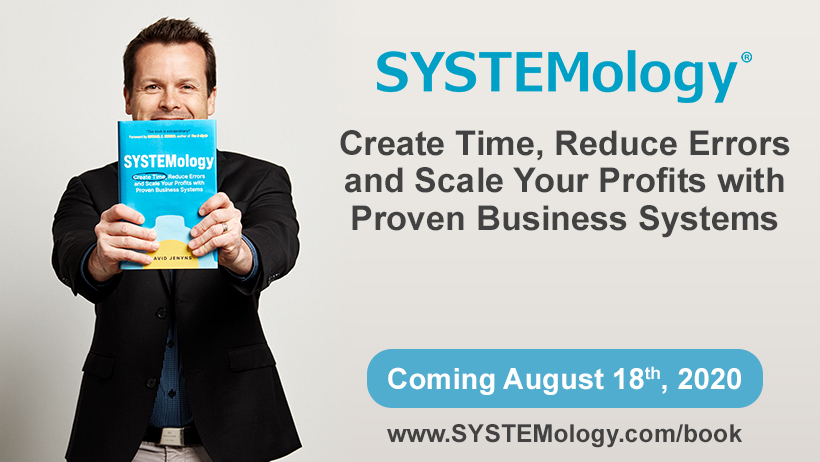How Systems Allow for More Creativity in Your Firm

David Jenyns is the author of SYSTEMology, the host of the Business System Simplified podcast, and the owner of systemhub.com. In the past, David helped accounting and bookkeeping firms build solid, effective systems within their business operations, making their businesses scalable.
In this podcast, David illustrates the importance of systemizing and refining critical client flow by using a case study involving a company in Australia that services the agricultural sector.
Podcast
Summary
- Misconceptions: Creativity and Control In Systemization
- Critical Client Flow
- The First Problem
- A Case Study
Resources
Related Sources
- How to Streamline Your Business to Run Without You
- Use DOWNTIME to increase your firm’s productivity
- 7 Habits of Highly Successful Accounting Firm Owners
Misconceptions: Creativity and Control In Systemization
When firm and business owners first think about systemization and how to apply it in their business, feelings may vary based on the misconceptions they have about systemizing. Some may first become excited at the prospect of gaining more control over their operations. Others worry that creativity, the unique touch that clients experience, will disappear under a unified system.
However, David Jenyns urges that this is far from the truth. Having systemized his own business, allowing him to take a much-needed bird’s-eye view of its operations, he believes that many businesses have problems that can use systemization as a solution.
Some firm owners first think of the business operations of McDonald’s when they think of systemizing their business, but McDonald’s methods are overkill—if not a death sentence—for small to medium-sized businesses. Other owners think they will lose control of their operations if they systematize. In reality, systems let businesses use their team talent and resources at full effectiveness. Implementing systems can also help to encourage creativity among employees by pushing them to shine as they take ownership of their work and suggest changes to make the entire business work better. Thus, having excellent systems can improve employee morale.
David passionately claims that systems for the important processes of your business “…frees you or your team members up to do your best work and be creative because you don’t have to think about all the little things.” Implementing systems smartly shifts your business at a cultural level while also positioning your business to become scalable in the long run.
Critical Client Flow
Establishing a system creates a cultural shift in your organization, changing how you look at business operations. Eventually, David states, you will always look for a systemized solution, but this ability comes with time. For those starting off, it can seem pretty intimidating to even know where to start.
“Start simple,” David advises.
The first step firm owners should take is to systemize the critical client flow. David says, “if you can replicate the delivery—the core product or service—and have it happen without key person dependency, that ends up being a huge win.” Key person dependency refers to heavily relying on one person to serve your client. This is a key element that, if done properly, can aid in redistributing tasks and removing duplication of effort.
As for how to do this, you first have to collect some information, and you will need at least two people: one person who documents the action, and another person who has first-hand knowledge—a subject expert—of how to perform the tasks. This is the key information you’ll need to collect to identify your current critical client flow:
- Target Audience: Be as specific as possible, identifying the ideal person your core product or service is for.
- Core Product or Service: Describe the great product you made for your target audience.
- Method of Gaining Attention: Imagine the linear order that the business and client go through from gaining their attention to delivering the product. How do you capture their attention? How do you generate leads?
- Understanding How Inquiries are Handled: How do you respond when your inquiry comes in? Do you have a discovery meeting?
- Sales Sequence: What is your sales sequence?
- Methods of Accepting Payment: How do you accept your client’s money? Do you invoice upfront or do everything at the end?
- Onboarding Processes: How do you onboard the client? How do you set them up inside their Jetpack Workflow or QBO account? Could you use Zapier integrations to reduce duplication and time?
- Role Definition: What are the key steps for doing your work?
- Retention and Handover: What does the handover look like? How do you get clients and customers to come back?
For a moment, let’s focus on role defining. By defining the role of a position in your business, you can delegate tasks effectively. This can be tough for business owners with poor systems. David says that the business owner often feels like “the Knight in shining armor that solves every problem in the business.”
The First Problem: The Business Owner
The firm owner—especially in small-scaled businesses—wears many hats. They are the gatekeeper through which all things pass through. For the business owner, their task is to know when it is necessary to delegate and figure out how to do it effectively.
Earlier, we mentioned how one misconception of systemization is losing control of business operation processes. This is the road to micromanagement. Because habits from executives rub off on employees, this affects the business’s culture and work environment, usually for the negative. Your systems should help keep workers in line with your parameters so you don’t have to check them all of the time.
A Case Study
David recalls an Australian-based company called McHaney and Co. that was working in regional Victoria. They are in the business of helping farmers to manage their farms. The company has several departments, and there was a particular situation with one specific department that is most vivid in David’s memory. “They had recognized that two ladies were really delivering the bulk of the work in that particular department, and team members weren’t able to really take leave.” This is a prime example of how an aspect of the critical client flow had become key person dependent.
This had practical implications. Business leaders at McHaney worried if a team member needed to take time off, then everything would just grind to a halt. No one would help the clients, or at least, the clients would not be receiving consistent, quality service.
As David captured the critical systems and learned the process, he shared this information throughout the different departments so they could follow the same process. Each department operated with enough autonomy that they were each functioning a little like a micro-business. So there was incredible value in sharing relevant portions of the discovered process from one department to another.
David Jenyns provided a lot of valuable information in the full episode, and we recommend that you listen to the podcast and watch the video. If you’d like to reach out to David Jenyns directly, you can reach out to him at systemology.com. If you’re interested in systems and would like to join his book’s pre-launch list, sign up here. The book will be available on August 18th, 2020.






